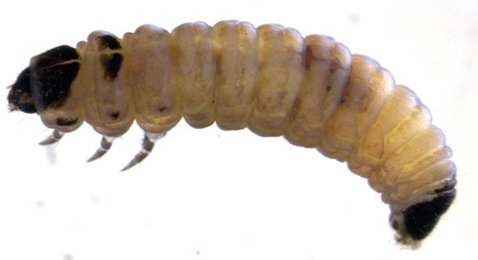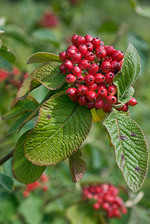|
||||||
|
VIBURNUM. Wayfaring-tree, Guelder-rose and Laurustinus. [Caprifoliaceae] |
|
|
Six species and two hybrids of Viburnum are recorded in Britain. These include Wayfaring-tree (V. lantana), Guelder-rose (V. opulus) and Laurustinus (V. tinus). Three British miners are recorded on Viburnum in Britain. A key to the European miners recorded on Viburnum is provided in Bladmineerders van Europa. |
|
|
Key for the identification of the known mines of British |
1a > Leaf-miner and case-bearer: The larva lives outside the mine, protected by a case, and feeds on the underlying plant tissues via a hole cut in the epidermis. From that point it eats away as much leaf tissue as it can reach without fully entering the mine. Mine does not contain frass (Coleophora species) |
1b > Leaf-miner, but not a case-bearer: The larva lives mainly inside the mine. Mine usually contains frass. In later instars the larva may live sandwiched between two more or less circular sections cut from the leaf. |
2a > Leaf-miner: Lobe case. The full grown case is about 7 mm long. The mouth angle is 0°, causing the case to lie flat on the leaf. The case is gradually enlarged by the addition of rings that are cut out of the epidermis. The rings become gradually larger, and stick irregularly out of the contour of the case. The rings are cut out of the lower epidermis of the mine. This implies that mines may have both normal, small openings, and large ones. Compare for instance C. violacea, that cuts rings out of the upper epidermis. The larva feeds briefly initially and again after over wintering. It then aestivates until Autumn. It makes one case which it enlarges by adding pieces of excised lower epidermis. |
|
Coleophora ahenella Heinemann, 1877 [Lepidoptera: Coleophoridae]. |
2b > Leaf-miner: The larva feeds on a wide range of trees, shrubs and herbs, favouring Rosaceae, but not exclusively. The fully developed cased larva may be found active in October and again, after winter diapause, in April. Cases, about 6 mm, of diapausing larvae may be found through winter, fixed to a tree or fence post. The dorsal surface of the case is usually covered in leaf fragments, but they can sometimes be worn off almost smooth. The ventral surface is swollen at the middle and has a keel, which usually bends upwards at the posterior. The cases of C. ahenella (on Rhamnus, Frangula, Viburnum and Cornus) and C. potentillae (case less swollen, keel not bent up, resting position less prone) are very similar. Brownish lobe case that lies almost flat on the leaf, either on the upper or on the lower side. Case widest about the middle. Ventrally there is a distinct keel. Mouth angle 0°. Full depth mines rather large. The flaps of cuticular tissue that serve to enlarge the case are cut out of the upper epidermis. (contrary to C. ahenella and C. potentillae, that use tissue from the lower epidermis). The removal of these tissue flaps creates holes that are much larger than those that serve as the entrance to the mine. |
 Coleophora violacea larva, lateral Image: © Willem Ellis (Bladmineerders van Europa) |
|
Coleophora violaceae (Ström 1783) [Lepidoptera: Coleophoridae]. |
3 > Leaf-miner: The mine is underside, between veins, causing leaf to arch. The lower epidermis is at first white, then brown. Lower-surface tentiform mine, white at first, later brown, between two side veins. Pupa without a recognisable cocoon in the mine. Before ecdysis the pupa works itself halfway out of the upperside of the mine. |
|
Phyllonorycter lantanella (Schrank, 1802) [Lepidoptera: Gracillariidae]. |
| Last updated 13-Feb-2018 Brian Pitkin | ||

